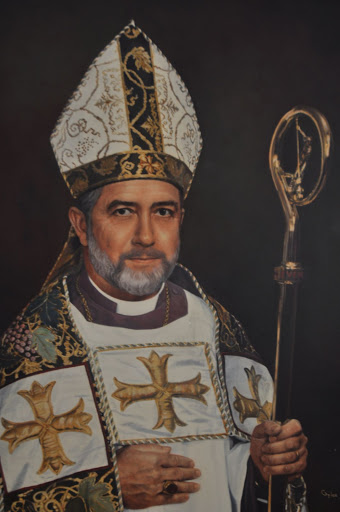A former United Churches of Christ Navy Chaplain became the Seventh Bishop of Georgia, leading the diocese through a time of great change in the church. G. Paul Reeves was born in Roanoke, Virginia on 14 October 1918. He graduated from Randolph Macon, and in 1943 from Yale Divinity School. On leaving the Navy in 1948, he was ordained an Episcopal priest in the Diocese of Florida. He and his wife Adele had two children.
 Canonically resident in the Diocese of South Florida at the time of his election, he was consecrated bishop coadjutor to serve alongside Bishop Albert Rhett Stuart in Christ Church, Savannah, on September 30, 1969. Bishop Reeves became diocesan bishop on Stuart’s retirement in 1972. In his first Convention address he stressed the centrality of Holy Eucharist as the norm for Sunday worship and the obligation of faithful, regular attendance at church.
Canonically resident in the Diocese of South Florida at the time of his election, he was consecrated bishop coadjutor to serve alongside Bishop Albert Rhett Stuart in Christ Church, Savannah, on September 30, 1969. Bishop Reeves became diocesan bishop on Stuart’s retirement in 1972. In his first Convention address he stressed the centrality of Holy Eucharist as the norm for Sunday worship and the obligation of faithful, regular attendance at church.
Bishop Reeves held regular clergy conferences and retreats at Honey Creek which sometimes included spouses. In 1972, he sent a group of clergy and laity to Dallas, Texas, to participate in Cursillo who subsequently initiated the program in Georgia. Evangelism and renewal were encouraged and supported by regular Cursillo weekends at Honey Creek and similar Happening events for high school youth. He continued the Companion Diocese program formed under Bishop Stuart with Guiana on the Northern Coast of South America.
In his 1977 Address to Convention, Bishop Reeves said, “I do not apologize for saying that there is a great deal badly wrong in our Church today. I may surprise – even disappoint – some of you by confining my remarks about the ordination of women to one sentence. In my opinion, the provision for ‘ordination’ of women to the priesthood probably was the most serious single mistake the Episcopal Church has made in the nearly 200 years of its history.”
In his 1983 Address Bishop Reeves stated, “Most emphatically I am not suggesting a return to the 1928 Book, nor a criticism of our present Book. I am suggesting a criticism of the process that produced the Book…. I would like to see us, one and all, cheerfully use it as the quite adequate instrument it is for our corporate worship.”
 To name Bishop Reeves solely as a conservative in a theologically-divided church fails to capture the gifts he brought to his call. Bishop Harry Shipps wrote that, “Reeves was a conservative gentleman with a dry sense of humor. He held a high view of the Church and our individual and corporate responsibility to it as stewards.”
To name Bishop Reeves solely as a conservative in a theologically-divided church fails to capture the gifts he brought to his call. Bishop Harry Shipps wrote that, “Reeves was a conservative gentleman with a dry sense of humor. He held a high view of the Church and our individual and corporate responsibility to it as stewards.”
“There’s an art form to a worship service, particularly an Episcopal service,” said his godson Mills Fleming, “I think his strength was in the liturgy. He was a consummate liturgist.”
Bishop Reeves established seven congregations in the diocese during his episcopacy: St. Francis of Islands in Savannah, and St. Mary Magdalene in Louisville, both in 1976; All Saints in Thomasville, Atonement in Hephzibah, and St. Barnabas in Valdosta, in 1980; St. Thomas Aquinas in Baxley, in 1982; and St. Elizabeth of Hungary in Richmond Hill, in 1983.
Because of what he named as an increasingly liberal agenda of the General Convention, Bishop Reeves did not attend General Conventions and House of Bishops meetings during his final years as Diocesan. Bishop Reeves retired in February 1985 upon succession of his coadjutor bishop, Harry W. Shipps. He died April 15, 2010. His Requiem Mass was celebrated in St. John’s in Savannah.
Pictured: (top) Bishop Albert Rhett Stuart at left with Bishop Paul Reeves at right when Stuart was the diocesan and Reeves the Bishop Coadjutor, and (bottom) Bishop Reeves in the cope and mitre the Archbishop of the Anglican Church in Japan gave to Bishop Stuart in the 1950s.
